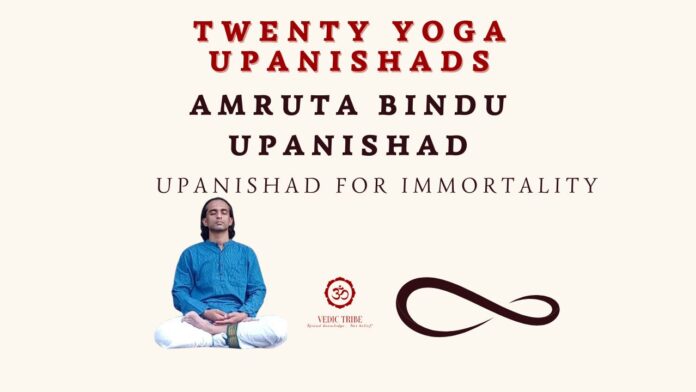What is “Amruta Bindu”?
In the previous article, we discussed Hamsa Upanishads and in this article, we will discuss – Amritabindu Upanishad.
Amritabindu: The term “Amritabindu” literally translates to “drop of nectar” or “drop of immortality.” It symbolizes the subtle sound of “Om,” which is considered the primordial sound of the universe. The Upanishad states that meditation upon the sound of “om” helps the practitioner realize the almighty as “Shabda-Brahma”.
Shabda-brahman: This Upanishad explains mind as the cause of bondage and suggests meditating upon “Shabda-brahman”. Hamsa Upanishad and Yoga Shiksha Upanishad also suggest meditating upon “Shabda-brahman”
Bindu – a transcendental idea:
From dimensionless reality: Sankhya philosophy posits that the perceived dimensional universe, or jada-prakriti, originates from a dimensionless primordial substance, moola prakriti. This moola prakriti undergoes a sequential transformation, beginning with mahat-tattva, which introduces dimensionality, and subsequently evolving into the subtle and gross material world. Thus, a dimensionless foundation underlies all perceptible material reality.
Bindu – with no measurable size: In geometric terms, a point is a dimensionless object. This means it has no physical dimensions—no length, width, or height. A point is actually an approximation of a true point and a true point is infinitely small, so small that it has no measurable size.
Dimensionless cosmic consciousness: In deep meditation, Vedic sages experienced the dimensionless nature of the cosmos and discerned the animating presence of a dimensionless cosmic consciousness throughout all existence. This profound insight was codified as “Bindu” in Nadabindu Upanishad, Amrutabindu Upanishad, Amruta Nada Bindu Upanishad and Dhyanabindu Upanishad.
Mind as a cause of bondage and tool of liberation:
Conduit for all external experiences: In Vedanta, the universe is referred to as the “Brahmanda,” while the human body is called the “Pindanda.” The physical body serves as a bridge between the individual and the cosmos, acting as a conduit for all external experiences. These experiences are first processed by the mind, which then transmits them to the Jeevatma, the individual soul.
Attachment: Consequently, the Jeevatma’ s perception of the physical world is filtered through the lens of the mind. This inherent nature of the mind leads to outward focus and attachment to material experiences, hindering spiritual growth.
Bondage & liberation: The Amritabindu Upanishad explains that mind is both – cause of bondage and a tool of liberation. It explains that when the mind is affected by desires it becomes impure and causes bondage. When the mind is free from desires, it becomes a tool for liberation. In Bhagavad Gita, Lord Krishna also lays down the exact teaching (6:5).
Tool: Through disciplined practices like self-regulation and meditation, the mind can be redirected inward. When this occurs, the mind becomes a potent tool for spiritual exploration. It enables deep contemplation, meditation, and the realization of the divine within. By turning inward, the Jeevatma can transcend the limitations of the physical body and connect with the ultimate reality.
Shabda Brahma:
Bhagavad Gita: Lord Krishna says, Yogis are always drawn to “Shabda Brahma” (6.44). Hence, the ancient Yogic practices always centred around the primordial sound “OM”.
Pranava: The Upanishad says that “Pranava” (Om), the physical sound has “Parabrahma” at its essence. Hence, it calls Parabrahma as “Shabda Brahma”. For those who meditate upon the sound of “om”, this aspect of Parabrahma is revealed first.
Buddhism: In Buddhism, “Om” is uttered at the beginning of Matras like “Om mani padme hum”. In Vajrayana Buddhism, “Om” is considered “Beeja Mantra” (the seed of Mantras). In Japanese Buddhism, (specially Mikkyo Buddhism) “A-un”, the transliteration of “om” – is contemplated as beginning and end of Universe.
“Om” in meditation:
Yoga Upanishads: Yoga Upanishads record the Yogic experiences of Rishis and univocally establish the meditation techniques centred upon Pranava (om). Meditation upon different aspects of Pranava is at the core of the ancient Yogic practice. This is affirmed in Bhagavad Gita, Tantra texts and many other scriptures in Vedic tradition.
Contemporary meditation techniques: Many contemporary meditation techniques, though posing as – Yogic, Tantric…etc does not contain contemplation or practice of Pranava. Due to this, such practices lose the spiritual potential and becomes a mere mental exercise. One should first understand the underlying spiritual essence of Pranava as a whole and follow only such practices centred around Pranava.
Takeaways:
– Study this Upanishad and incorporate “Shabda-brahma” in your meditation.
– If you encounter any meditation technique which does not involve chanting of “Om”, question its authority and effectiveness.
In the next article, we will discuss – “Nadabindu Upanishad”.
Madhwesh K
Vedic Tribe

